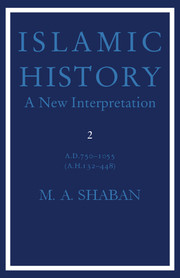Book contents
- Frontmatter
- Contents
- Acknowledgements
- Preface
- 1 The founding of the ʿAbbāsid regime
- 2 Towards a civil war
- 3 Dissolution under a new regime
- 4 The origins of the iqṭāʿ
- 5 Regional economic conflicts
- 6 The breakdown of the central government (I)
- 7 The breakdown of the central government (II)
- 8 The Būyid confederacy
- 9 The Fātimids
- Works cited
- Index
4 - The origins of the iqṭāʿ
Published online by Cambridge University Press: 05 June 2012
- Frontmatter
- Contents
- Acknowledgements
- Preface
- 1 The founding of the ʿAbbāsid regime
- 2 Towards a civil war
- 3 Dissolution under a new regime
- 4 The origins of the iqṭāʿ
- 5 Regional economic conflicts
- 6 The breakdown of the central government (I)
- 7 The breakdown of the central government (II)
- 8 The Būyid confederacy
- 9 The Fātimids
- Works cited
- Index
Summary
For the researcher in Islamic history the study of the next period of almost a quarter of a century 847–70/232–56 ought to be an easy task. There are detailed reports rich with information about the rapidly developing changes, especially in the heart of the empire. Yet, these very reports tend to confuse and blur rather than clarify the issues involved. This period is characterized by long and complicated fighting between the military forces of Baghdād and Sāmarrā and even among the forces in each of these centres. The names of the principal leaders involved in this bitter struggle are mentioned in the sources and so are the groups that supported them. As there were no regimental names as such, army groups were given various nomenclatures, but in some cases different groups were described by the same name. What is important is whether the particular group in question belonged to Baghdād or Sāmarrā, e.g. the shākiriyya. Without identifying each group and its leader no real understanding of the causes of the struggle can be obtained. As this period contained the germs of military and administrative iqṭāʿ, such an understanding is vital for the analysis of later developments. In their valuable studies on this subject neither Cl. Cahen nor A. K. S. Lambton has made the necessary effort to clarify these beginnings.
Arabic sources like us to believe that Wāthiq was so little interested in ruling that he did not even want to take the trouble to nominate a successor.
- Type
- Chapter
- Information
- Islamic HistoryA New Interpretation, pp. 71 - 88Publisher: Cambridge University PressPrint publication year: 1976



